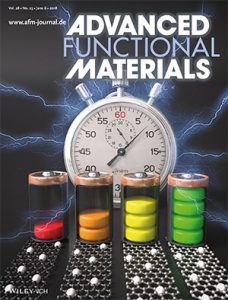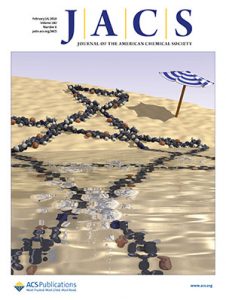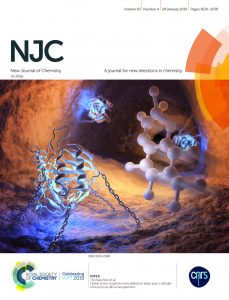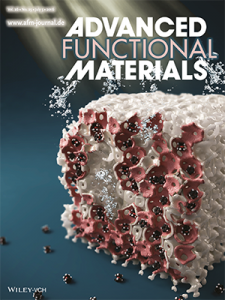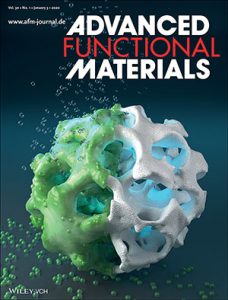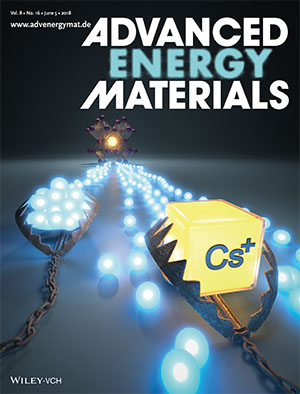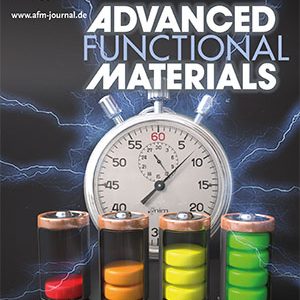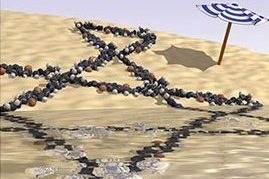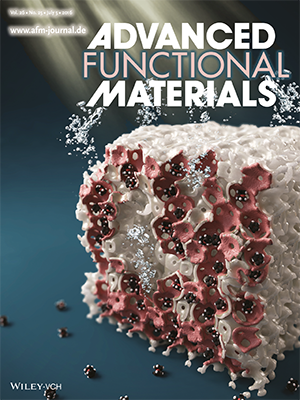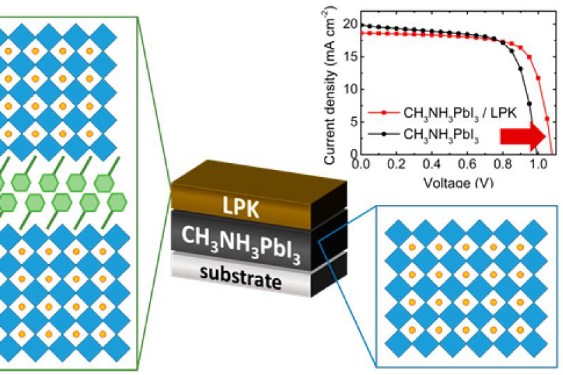RECENT HIGHLIGHTS
Efficient OER Catalyst with Low Ir Volume Density Obtained by Homogeneous Deposition of Iridium Oxide Nanoparticles on Macroporous Antimony-Doped Tin Oxide Support, D. Boehm; M. Beetz; M. Schuster; K. Peters; A. G. Hufnagel; M. Doeblinger; B. Boeller; T. Bein and D. Fattakhova-Rohlfing, Adv. Funct. Mater., 30, 2020. [link]
A multistep synthesis procedure for the homogeneous coating of a complex porous conductive oxide with small Ir nanoparticles is introduced to obtain a highly active electrocatalyst for water oxidation. At first, inverse opal macroporous Sb doped SnO2 (ATO) microparticles with defined pore size, composition, and open‐porous morphology are synthesized that reach a conductivity of ≈3.6 S cm−1 and are further used as catalyst support. ATO‐supported iridium catalysts with a controlled amount of active material are prepared by solvothermal reduction of an IrOx colloid in the presence of the porous ATO particles, whereby homogeneous coating of the complete outer and inner surface of the particles with nanodispersed metallic Ir is achieved. Thermal oxidation leads to the formation of ATO‐supported IrO2 nanoparticles with a void volume fraction of ≈89% calculated for catalyst thin films based on scanning transmission electron microscope tomography data and microparticle size distribution. A remarkably low Ir bulk density of ≈0.08 g cm−3 for this supported oxide catalyst architecture with 25 wt% Ir is determined. This highly efficient oxygen evolution reaction catalyst reaches a current density of 63 A gIr−1 at an overpotential of 300 mV versus reversible hydrogen electrode, significantly exceeding a commercial TiO2‐supported IrO2 reference catalyst under the same measurement conditions.
Highly active enzymes immobilized in large pore colloidal mesoporous silica nanoparticles, D. Gößl, H. Singer, H.-Y. Chiu, A. Schmidt, M. Lichtnecker, H. Engelke and T. Bein, New Journal of Chemistry, 4, 2019. [link]
Understanding the Role of Cesium and Rubidium Additives in Perovskite Solar Cells: Trap States, Charge Transport, and Recombination. Y. Hu, E. M. Hutter, P. Rieder, I. Grill, J. Hanisch, M. F. Aygüler, A. G. Hufnagel, M. Handloser, T. Bein, A. Hartschuh, K. Tvingstedt, V. Dyakonov, A. Baumann, T. J. Savenije, M. L. Petrus, P. Docampo, Adv. Energy Mater. 2018, 8, 1703057. [link]
Making Ultrafast High‐Capacity Anodes for Lithium‐Ion Batteries via Antimony Doping of Nanosized Tin Oxide/Graphene Composites. F. Zoller, K. Peters, P. M. Zehetmaier, P. Zeller, M. Döblinger, T. Bein, Z. Sofer, D. Fattakhova-Rohlfing, Adv. Funct. Mater. 2018, 28, 1706529. [link]
Oriented Films of Conjugated 2D Covalent Organic Frameworks as Photocathodes for Water Splitting. T. Sick, A. G. Hufnagel, J. Kampmann, I. Kondofersky, M. Calik, J. M. Rotter, A. M. Evans, M. Döblinger, S. Herbert, K. Peters, D. Boehm, P. Knochel, D. D. Medina, D. Fattakhova-Rohlfing, T. Bein, J. Am. Chem. Soc. 2018, 140, 2085–2092. [link]
Light-driven water electrolysis at a semiconductor surface is a promising way to generate hydrogen from sustainable energy sources, but its efficiency is limited by the performance of available photoabsorbers. Here we report the first time investigation of covalent organic frameworks (COFs) as a new class of photoelectrodes. The presented 2D-COF structure is assembled from aromatic amine-functionalized tetraphenylethylene and thiophene-based dialdehyde building blocks to form conjugated polyimine sheets, which π-stack in the third dimension to create photoactive porous frameworks. Highly oriented COF films absorb light in the visible range to generate photoexcited electrons that diffuse to the surface and are transferred to the electrolyte, resulting in proton reduction and hydrogen evolution. The observed photoelectrochemical activity of the 2D-COF films and their photocorrosion stability in water pave the way for a novel class of photoabsorber materials with versatile optical and electronic properties that are tunable through the selection of appropriate building blocks and their three-dimensional stacking.
Zinc Ferrite Photoanode Nanomorphologies with Favorable Kinetics for Water-Splitting. A. G. Hufnagel, K. Peters, A. Müller, C. Scheu, D. Fattakhova-Rohlfing and T. Bein, Adv. Funct. Mat. 2016, 26, 4435-4443. [link]
The n-type semiconducting spinel zinc ferrite (ZnFe2O4) is used as a photoabsorber material for light-driven water-splitting. It is prepared for the first time by atomic layer deposition. Using the resulting well-defined thin films as a model system, the performance of ZnFe2O4 in photoelectrochemical water oxidation is characterized. Compared to benchmark α-Fe2O3 (hematite) films, ZnFe2O4 thin films achieve a lower photocurrent at the reversible potential. However, the oxidation onset potential of ZnFe2O4 is 200 mV more cathodic, allowing the water-splitting reaction to proceed at a lower external bias and resulting in a maximum applied-bias power efficiency (ABPE) similar to that of Fe2O3. The kinetics of the water oxidation reaction are examined by intensity-modulated photocurrent spectroscopy. The data indicate a considerably higher charge transfer efficiency of ZnFe2O4 at potentials between 0.8 and 1.3 V versus the reversible hydrogen electrode, attributable to significantly slower surface charge recombination. Finally, nanostructured ZnFe2O4 photoanodes employing a macroporous antimony-doped tin oxide current collector reach a five times higher photocurrent than the flat films. The maximum ABPE of these host–guest photoanodes is similarly increased.
Intracellular chromobody delivery by mesoporous silica nanoparticles for antigen targeting and visualization in real time. H.-Y. Chiu, W. Deng, H. Engelke, J. Helma, H. Leonhardt and T. Bein, Scientific Reports 2016, 6, 25019. [link]
Chromobodies have recently drawn great attention as bioimaging nanotools. They offer high antigen binding specificity and affinity comparable to conventional antibodies, but much smaller size and higher stability. Chromobodies can be used in live cell imaging for specific spatio-temporal visualization of cellular processes. To date, functional application of chromobodies requires lengthy genetic manipulation of the target cell. Here, we develop multifunctional large-pore mesoporous silica nanoparticles (MSNs) as nanocarriers to directly transport chromobodies into living cells for antigen-visualization in real time. The multifunctional large-pore MSNs feature high loading capacity for chromobodies, and are efficiently taken up by cells. By functionalizing the internal MSN surface with nitrilotriacetic acid-metal ion complexes, we can control the release of His6-tagged chromobodies from MSNs in acidified endosomes and observe successful chromobody-antigen binding in the cytosol. Hence, by combining the two nanotools, chromobodies and MSNs, we establish a new powerful approach for chromobody applications in living cells.

Hybrid Perovskite/Perovskite Heterojunction Solar Cells. Y. Hu, J. Schlipf, M. Wussler, M. L. Petrus, W. Jaegermann, T. Bein, P. Muller-Buschbaum and P. Docampo, ACS Nano 2016, 10, 5999-6007. [link]
Recently developed organic–inorganic hybrid perovskite solar cells combine low-cost fabrication and high power conversion efficiency. Advances in perovskite film optimization have led to an outstanding power conversion efficiency of more than 20%. Looking forward, shifting the focus toward new device architectures holds great potential to induce the next leap in device performance. Here, we demonstrate a perovskite/perovskite heterojunction solar cell. We developed a facile solution-based cation infiltration process to deposit layered perovskite (LPK) structures onto methylammonium lead iodide (MAPI) films. Grazing-incidence wide-angle X-ray scattering experiments were performed to gain insights into the crystallite orientation and the formation process of the perovskite bilayer. Our results show that the self-assembly of the LPK layer on top of an intact MAPI layer is accompanied by a reorganization of the perovskite interface. This leads to an enhancement of the open-circuit voltage and power conversion efficiency due to reduced recombination losses, as well as improved moisture stability in the resulting photovoltaic devices.

